|
21 April 2019 (Sun), 19:00 World famous Bolshoi Ballet and Opera theatre (established 1776) - Small Stage - Stars of the Stars Classical Ballet Boris Asafiev "Flames of Paris" (Ballet in three acts) Tickets available only at OperaAndBallet.com

Running time: 2 hours 15 minutes (till 21:15)
The performance has 1 intermission
Schedule for Boris Asafiev "Flames of Paris" (Ballet in three acts) 2022
Conductor: Pavel Sorokin
Dancer: Irina Zibrova
Dancer: Ruslan Skvortsov
Dancer: Alexei Loparevich
Dancer: Andrei Sitnikov
Dancer: Vyacheslav Lopatin
Dancer: Alexander Voytyuk
Dancer: Vladislav Lantratov
Dancer: Anastasia Vinokur
Dancer: Kristina Kretova
Dancer: Karim Abdullin
Dancer: Alexander Vodopetov
Dancer: Nelli Kobakhidze
Dancer: Olga Kishnyova
Dancer: Daria Khokhlova
Dancer: Yuri Ostrovsky
Dancer: Yegor Simachev
Dancer: Maria Mishina
Dancer: Artemy Belyakov
Dancer: Vera Borisenkova
Dancer: Daria Bochkova
Dancer: Anastasia Denisova
Dancer: Angelina Vlashinets
Composer: Boris Asafiev
Light Designer: Damir Ismagilov
Music Director: Pavel Sorokin
Dancer: Alexander Petukhov
Director: Alexei Ratmansky
Choreography: Vasily Vaynonen
Choreography: Yuri Burlaka
Scenography: Evgeny Monakhov
Scenography: Ilya Utkin
Costume Designer: Elena Markovskaya
Orchestra: Bolshoi Theatre Symphony Orchestra
Ballet company: Bolshoi Ballet
Classical Ballet in 3 act
Premiere of this production: 03 July 2008, Bolshoi Theatre, Moscow, Russia
Alexei Ratmansky’s new version
The Flames of Paris was first presented by Vasily Vaynonen at the Bolshoi in 1933, with decor by Vladimir Dmitriev, and Yuri Fayer conducting; the lead roles were danced by Vakhtang Chabukiani and Marina Semyonova. Revived in 1947, with Olga Lepeshinskaya, Alexei Ermolayev, Asaf Messerer and Sofia Golovkina, it was awarded a USSR State prize. The last production was in 1960 and remained in the repertoire till 1964.
The 20th century gave us the ballets of George Balanchine, Jerome Robbins, Frederick Ashton, Roland Petit, John Neumeier, Twyla Tharp - and all these names may be seen on Bolshoi billboards. (Along with the names of Christopher Wheeldon, Declan Donnellan, Pierre Lacotte who, in the 21st century, created productions specially for the Bolshoi Theatre). The 20th century, however, also has a rich Soviet legacy which has been well and truly forgotten and not always justifiably so. In many ballets of that time, after all, there were dances of great beauty on which more than one generation of dancers and spectators were brought up. Today there is a tendency throughout the world to return to narrative ballet and therefore the revival of works by the outstanding Russian 20th century choreographers is more than fitting.
In Memoriam of the Great French Revolution
Each of the Bolshoi Ballet's 'restoration' projects has its own specific character. The present project, perhaps, is one of the most interesting and unusual. The Flames of Paris belongs neither to the pearls of the pure classics of classical dance (take, for instance, the recently restored Le Corsaire), nor to the works of the Soviet period, which were subjected to uncalled for attacks at the hands of the powers that be (take, for instance, The Bright Stream). Though it did not disappear without trace, the greater part of it has been lost…
Produced in the 30's of the last century in Leningrad, at the then Kirov (today Mariynsky) Theatre, and soon transferred to the Bolshoi, it was to become one of Stalin's - who was not a particular fan of this genre of the performing arts - favorite ballets. The Flames of Paris was presented on the eve of the anniversary of the October Revolution, and later continued to be included in the ranks of works which were always brought out for an airing on anniversaries of this sort. And this is hardly surprising, the flames of Paris, after all, is about the conflagration of the great French Revolution. And it had a new 'hero' type which, up to then, had not been encountered in ballet - one of its main characters was the populace, revolutionary in mood and ready for action.
The 30's of the last century, saw the age of 'dramballet'. Theatre directors actively collaborated with the choreographers. Dance was called for only when justified by the development of the action. And the plot unfolded via pantomime, various forms of 'walk' and other devices of the sort. But Vasily Vainonen liked to mount dances and, since in his youth, he had been a character (folk) dancer, gave his preference to this dance form. His The Flames of Paris brought out on stage, virtually the whole Company and provided first-rate material for a demonstration of the brilliant skills of the numerous character dancers, there were also plenty of classical numbers to perform, both from the point of view of dance and acting. The plot, moreover, made it possible to avoid head-on collision with the canon of 'dramballet'. How, after all, if not via dance, was the populace expected to express its emotions?
Alexei Ratmanky, who likes to play with styles, could hardly have passed this title by. If it were not for Petipa, but also the achievements of the Soviet choreographers, Russian ballet would not have secured the position which it now occupies in the world. It is important to know one's history, particularly as, if its 'lessons' are not heeded to, they only too easily forgotten.
Delighting in Vainonen's rhythmically refined dance combinations - his nickname was Vaska-the syncopator - Ratmansky has attempted to make maximum use of the preserved fragments in his new ballet. Interwoven into its fabric, are the Vainonen Basque dance, the Mireille and Antoine Mistral pas de deux, the farandola, two carmagnoles and, of course, the famous Jeanne and Philippe pas de deux, the perennially popular ballet competition and concert number.
Choreographic considerations apart, Alexei Ratmansky was also motivated in his choice by 'ideological' factors. Perhaps, in our fairly cynical age, it is worth remembering how the aspiration to "freedom, equality and brotherhood" once had the power to bond people together. At any rate, it remains one of the finest slogans in mankind's history. On 14 July each year, the whole of France celebrates the anniversary of the great French Revolution. And the Marseillaise has become the national anthem.
But, for all that, a ballet is not a filmwhich cannot be modified and may be regarded, should the wish so take one, as no more than a memento of the age. Theatre is a live art. It demands dialogue, including dialogue with the 'original source'. And Alexei Ratmansky (with assistance from dramatist Alexander Belinsky) has entered into this dialogue. The plot has undergone several changes. Instead of one pair of chief characters, there are now two, linked to each other by the emotional ties of the love duet. The original version of this ballet was without a love line. But it was also without the execution of one of the main heroines, forcing her friends to quake in their shoes and giving them firsthand experience of the horrors of revolutionary terror.
It is difficult to list all the dancers participating in the production, there are many leading soloists, including talented soloists from the Bolshoi Ballet’s younger generation of dancers - Anna Antonicheva, Maria Alexandrova, Yekaterina Shipulina, Nina Kaptsova, Natalia Osipova, Vladimir Neporozhny, Andrei Mercuriev, Denis Savin, Ivan Vasiliev and many others. One of the interpreters of the role of Queen Marie Antoinette (there are three in all) is people's artist of the Soviet Union, today teacher-repetiteur, Lyudmila Semenyaka.
The first series of premiere performances took place on 3,4, 5 (morning and evening) and 6 July. The second will be on 15, 16 and 17 October.
Synopsis
Act I
Scene 1
A suburb of Marseilles, the town which gave its name to the French National anthem. Through the forest a large group of people are on the move. This is the battalion of theMarseillais who are on their way to Paris. A cannon which they are taking with them indicates their intentions. Among the men of Marseilles is Philippe.
It is by the cannon that Philippe makes the acquaintance of the peasant girl Jeanne. He kisses her on parting. Jeanne’s brother, Jerome, longs to join the Marseillais.
In the distance is the castle of the Marquis Costa de Beauregard, the local seigneur. Hunters are returning to the castle, among whom are the Marquis and his daughter, Adeline.
The ’noble’ Marquis makes advances to the pretty peasant girl, Jeanne. The latter tries to free herself from his pawing, but only manages to do so with the help of Jerome, who comes to hissister’s defense.
Jerome is beaten up by the hunters from the Marquis’s suite, and thrown into a prison cellar. Adeline, who has observed the scene, frees Jerome, and in their hearts a mutual feeling for each other isborn. The sinister, old woman Jarcasse, who has been employed by the Marquis to keep an eye on his daughter, informs her adored master of the escape. The Marquis slaps his daughter and orders her toget into a carriage, accompanied by Jarcasse. They are going to Paris.
Jerome bids farewell to his parents. It is not safe for him to remain on the Marquis’s estate. He and Jeanne go off with a detachment of the Marseillais. Their parents are inconsolable.
Volunteers are enrolling in the detachment. Together with the crowd, the men of Marseilles dance a farandola. The men put on red caps in place of their old headwear. Jerome is given a gun by theleader of the insurgents, Gilbert. Jerome and Philippe ’harness’ themselves to the cannon. The detachment moves off to Paris to the strains of the Marseillaise.
Scene 2
The sound of the Marseillaise gives way to an elegant minuet. The royal palace. The Marquis and Adeline have arrived here. The Master of Ceremonies announces the start of the ball.
Rinaldo and Armida, a court ballet, with the Paris stars Mireille de Poitiers and Antoine Mistral:
Sarabande — Armida and her friends. Armida’s forces return from a campaign. Prisoners are led in. Among them is Prince Rinaldo.
Amour aims an arrow at the hearts of Armida and Rinaldo. Variation — Amour. Armida frees Rinaldo.
Pas de deux Rinaldo and Armida.
The phantom of Rinaldo’s bride appears. Rinaldo abandons Armida and sails off in a boat after the phantom. Armida conjures up a storm. Waves cast Rinaldo onto the seashore, he is surrounded byfuries.
Dance — Furies. Rinaldo falls dead at Armida’s feet.
King Louis XVI and Marie Antoinette make their entrance. Greetings, oaths of loyalty and toasts to the prosperity of the monarchy follow.
The tipsy Marquis chooses the Actress as his next ’victim’, and starts to ’court’ her in the same way as he had Jeanne, the peasant girl. The strains of the Marseillaise are heard from thestreet. The courtiers and officers panic. Making use of this, Adeline escapes from the palace.
Act II
Scene 3
A square in Paris, into which the men of Marseilles march, among whom are Philippe, Jerome and Jeanne. A shot from their cannon is to give the signal for the start of the assaulton the Tuileries.
Suddenly, in the square, Jerome catches sight of Adeline. He rushes over to her. The sinister, old woman Jarcasse spies on their meeting.
In the meantime, in honor of the arrival of the detachment of men from Marseilles, a barrel of wine is rolled out into the square. Dances get underway: the Auvergne dance gives way to theMarseillaise dance, then the temperamental dance of the Basques starts up, in which all the chief characters take part: Jeanne, Philippe, Adeline, Jerome and Gilbert, the captain of theMarseillais.
In the crowd, flushed with wine, petty brawls break out here and there. Stuffed dolls of Louis and Marie Antoinette are torn to pieces. Jeanne with a spear in her hands dances the carmagnole to thesinging of the crowd. Philippe, who is drunk, lights the fuse, there is volley of cannon fire, after which the crowd dashes off to storm the Tuileries.
Against a background of shots being fired and the beating of drums, Adeline and Jerome declare their love for each other. They are oblivious to what is going on around them.
The Marseillais break into the palace. They are led by Jeanne, waving a flag. Fighting. The palace is taken.
Scene 4
The crowd fills the square which is decorated with lanterns. Members of the Convention and new government mount the tribune.
The crowd rejoices. The famous artists, Mireille de Poitiers and Antoine Mistral, who before had entertained the king and his courtiers, now perform the Freedom dance for the people. The new dance islittle different to the old, only now, the actress holds the Republican flag in her hands. Artist David is sketching the celebration.
By the cannon, from which the first volley had been fired, the President of the Convention unites the hands of Jeanne and Philippe. These are the first young newly weds of the new Republic
The sound of Jeanne and Philippe’s betrothal dance gives way to the muffled thuds of the falling knife of the guillotine.
The condemned Marquis is led in. Seeing her father, Adeline rushes over to him, but Jerome, Jeanne and Philippe beg her not to give herself away. In order to revenge the Marquis, Jarcasse betraysAdeline, revealing her true origins. Roused to fury, the crowd demands her death. Beside himself with despair, Jerome tries to save Adeline, but to no avail. She is guillotined. Frightened for theirlives, Jeanne and Philippe restrain the struggling Jerome.
The celebration continues. To the strains of Ca ira, the triumphant populace moves downstage towards the audience.
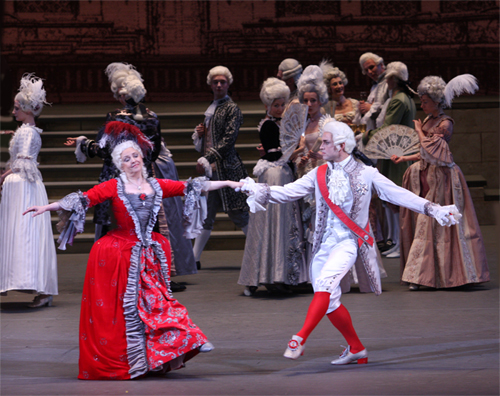
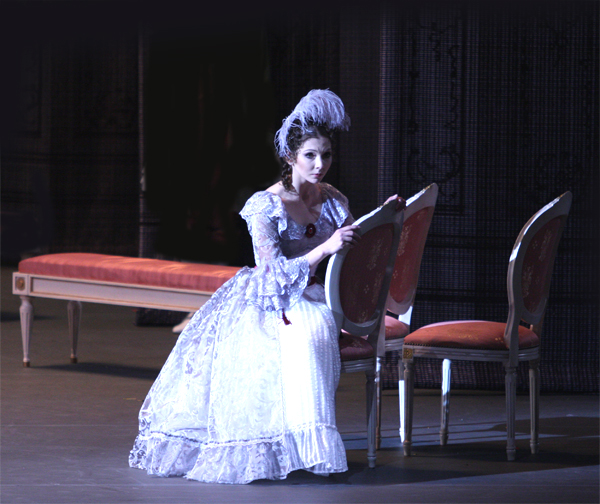
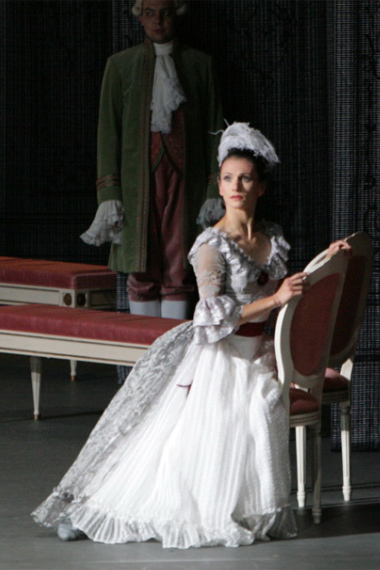
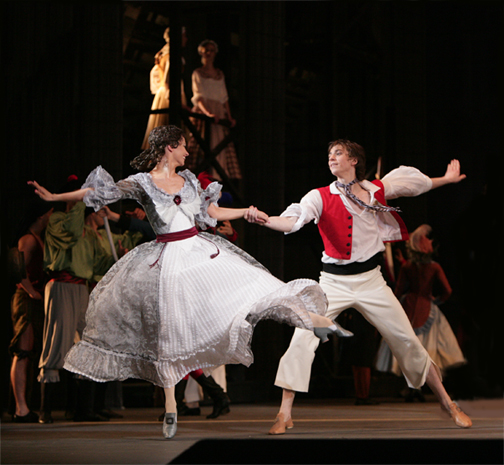








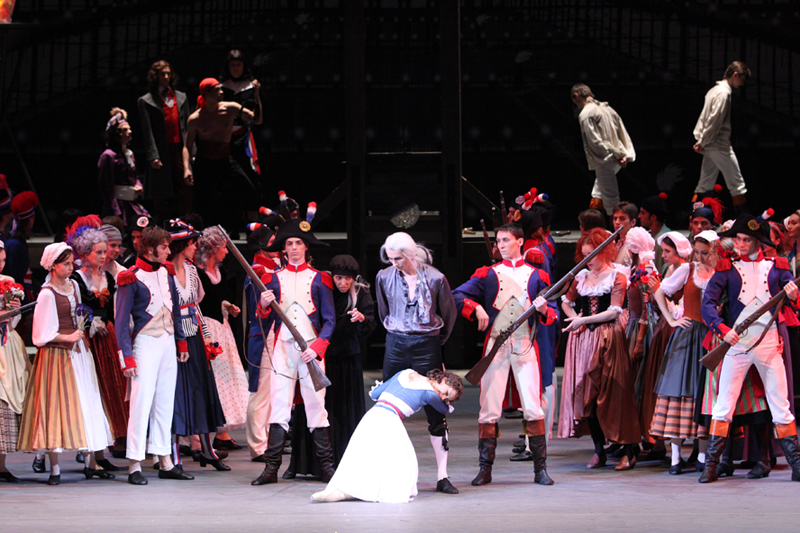
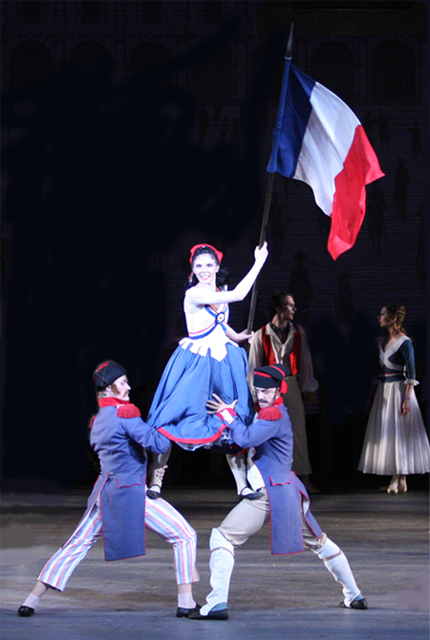




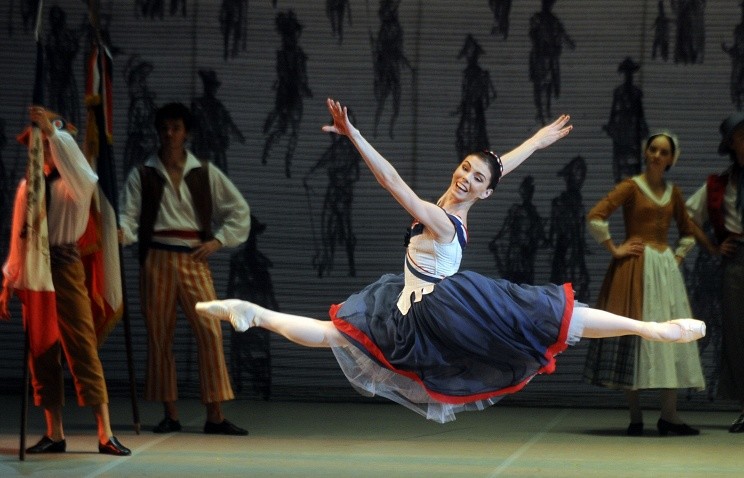
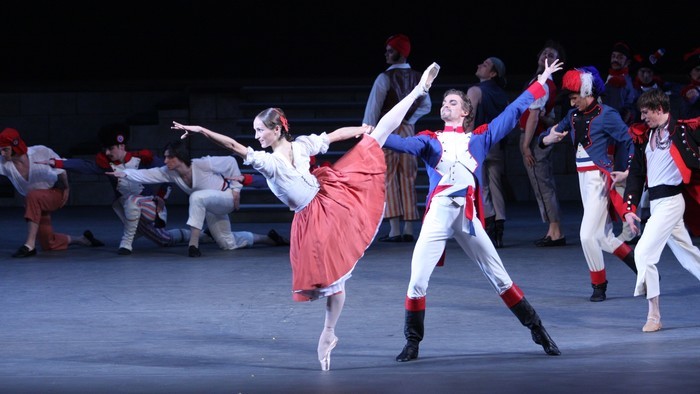
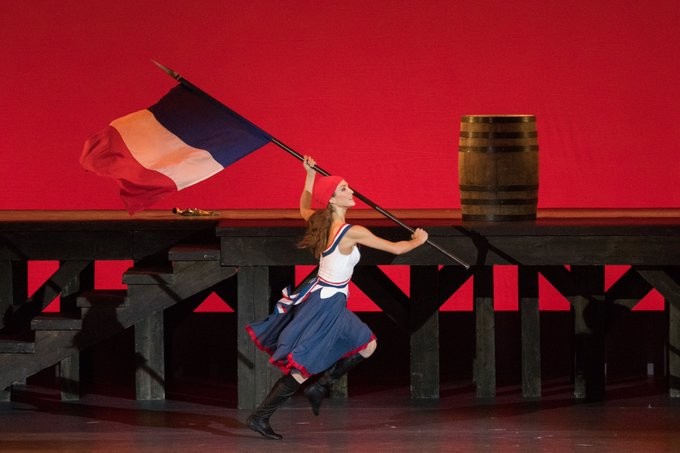

Schedule for Boris Asafiev "Flames of Paris" (Ballet in three acts) 2022
     
|



